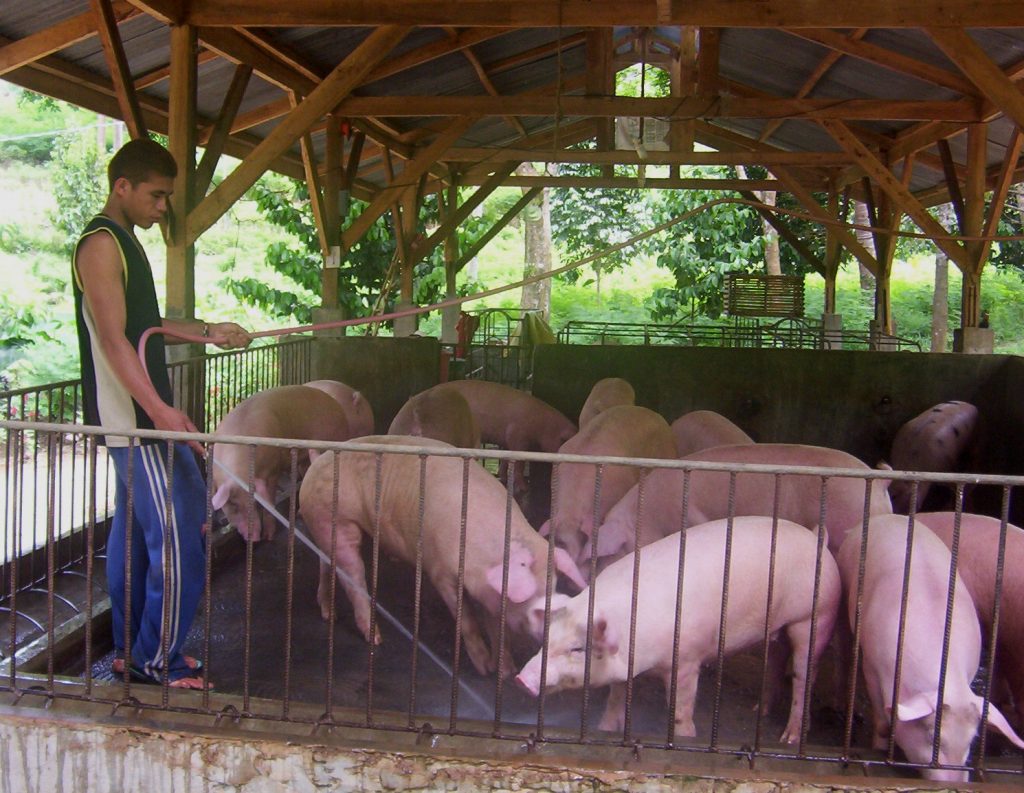
What many swine raisers in the country feared has finally been confirmed.
More than half (14 to be exact) out of the 20 blood samples from sick pigs that were sent to Pirbright, England tested positive of African swine fever (ASF).
“We received last week the laboratory test results coming from United Kingdom on this test called polymerase chain reaction (PCR) test. And 20 blood samples have been sent. And out of the 20, 14 are positive with African swine fever,” admitted Agriculture Secretary William D. Dar during a press conference.
PCR test is conducted to find small amounts of DNA in a sample, using a process known as amplification. “During PCR amplification,” explains the website, verywellhealth.com, “the DNA of interest is copied repeatedly until there is enough of it for analysis and detection.”
It must be recalled that when reports of “abnormal swine deaths in backyard farms” occurred in small backyard farms in Rizal and Bulacan provinces, the Department of Agriculture (DA) immediately directed the Bureau of Animal Industry (BAI) to collect and send blood samples to the World Reference Laboratory in Pirbright, England.
Aside from being the reference laboratory for ASF, UK is the home base of World Organization for Animal Health (OIE), an intergovernmental organization which coordinates, supports and promotes animal disease control.
Dar, in a post on his social media account, nevertheless said that “pork and pork products are safe to eat.” In fact, he was seen in a photographed boodle fight with Dr. Francisco T. Duque III of the Department of Health partaking different pork dishes with other government officials, hog stakeholders, and members of the private sector.
Dar stressed that as long as the hogs passed through the proper process of slaughtering and preparation, the public should not fear eating pork. “Before slaughtering,” he wrote in his post, “a hog is validated and assessed by a veterinarian, who then issues a medical certificate. Once slaughtered, the meats are stamped with a seal from the National Meat Inspection Service (NMIS), assuring that is has passed the food safety measures imposed by the government.”
For his part, Health Secretary Duque pointed out that local meat does not impose a threat to human health, and reiterated that as long as it is bought from reliable sources, prepared and cooked properly, it is safe for human consumption.
“ASF is not a threat to human health,” Duque added.
The OIE said ASF as “a severe viral disease affecting domestic and wild pigs.” It is responsible for serious production and economic losses. In the Philippines, swine production is a P260-billion peso industry, according to DA.
The “transboundary animal disease,” as OIE calls it, can be spread by live or dead pigs, domestic or wild, and pork products. “Transmission can also occur via contaminated feed and fomites (non-living objects) such as shoes, clothes, vehicles, knives, equipment, etc. due to the high environmental resistance of ASF virus.”
The ASF was first reported in China – the world’s largest pork producer – in August last year. It quickly spread to every province in the country. “Official numbers show 1.1 million pigs have been culled there, but experts believe the real number may have reached 200 million, or more than a third of the country’s herd,” The New Food Economy reports.
From there, ASF hopped the border into Vietnam, Laos, Cambodia, Mongolia and North Korea. Outbreaks have been reported in Africa and parts of Europe, South America, and the Caribbean. Now, it is reported in the Philippines.
Dr. Jaime A. Sison, a veterinarian who specializes in the area of pig and chicken and a regular columnist for MARID Agribusiness, said the symptoms of ASF include high fever, decreased appetite, skin lesions and diarrhea.
“The tricky thing about diagnosing a potential case of ASF is that it can look a lot like other more common diseases,” said Dr. Sison. “(Symptoms of ASF) is just like those of the common porcine epidemic diarrhea virus or classical swine fever.”
Dr. Sison urged swine farmers to report any suspected outbreaks to their local animal health officers, as it is much easier to test a false positive than to contain an outbreak that’s festered for days.
“ASF’s real calling card is its mortality rate: it claims almost all infected animals with 7-10 days of showing symptoms, and some drop dead much earlier – without showing any outward signs of illness,” Dr. Sison said.
In a DA bulletin, issued by Crisis Management Task Force (CMTF) on Swine on September 9, assured the public that it has “successfully managed the issue.”
The Swine CMTF has been commended “for overseeing the vigorous implementation of appropriate measures – notably the ‘1-7-10 Protocol’ – to effectively manage, contain and control the situation, as well provide timely and accurate information for all stakeholders and the general public.”
One refers to one-kilometer radius, also known as quarantine zone. It actually refers to “an area set to contain infection within one-kilometer radius from the affected farm by limiting animal movement and employing mandatory test and destruction of all infected animals.”
The 7 is for seven-kilometer radius, or what is called as surveillance zone. Here, “an area set within 7-kilometet radius intended to detect the extent of the infection through surveillance activities, disease reporting and limit the movement of live animals, animal products and by-products movement. Every movement outside this zone needs the required documents such as veterinary health certificates and shipping permits.”
The 10 is for the 10-kilometer radius, which is the control zone. Here, “an area set at 10-kilometer radius intended to detect infection at an early stage through mandatory disease reporting.”
In the DA bulletin, it said the agriculture department has also activated and mobilized respective Quick Response Teams (QRTs) at its regional office to implement complimentary measures.
As complimentary measures, the DA likewise issued three administrative orders:
“1. Guidelines in securing certificate of farm disease-free status in disease outbreak areas. This enables owner to get needed certification from DA-BAI, declaring their farm is disease-free, and not affected by current swine disease in subject area;
“2. Revised guidelines on the local movement of swine, pork, pork products and pork by-products outside disease outbreak areas. This policy strengthens current procedures on said subject; and
“3. Veterinary quarantine movement protocol during animal disease outbreaks/emergencies. This ensures a protocol is in place and to manage, contain and control a suspected swine disease.”
Currently, there is no approved vaccine for ASF. “The only way to stop this disease is to depopulate all affected or exposed swine herds,” Dr. Sison posted in his social media account. “On-farm biosecurity is crucial to preventing any animal disease from developing and spreading. All pig owners and anyone involved with pig operations should know and follow strict biosecurity practices to help protect our pigs from ASF. Work with your veterinarian to assess your biosecurity plans and make improvements as needed.”
The Philippines ranks third to China and Vietnam in terms of pig production in Asia, according to the UN Food and Agriculture Organization. Other top producers of pigs in the region are Japan, South Korea, Thailand, Indonesia, India and Malaysia.
Filipinos have been eating pork since time immemorial. “The Philippines, before it was even called the Philippines, has always favored pork,” wrote Gela Velasco, author of an article,The History of Meat in the Philippines: Why Our Markets Carry Chicken, Beef and Pork but Not Horse or Crocodile. “Pig meat was often raised as offerings to the gods to curry their favor. Pigs are also considered indigenous to our lands, with the Tagalog word ‘baboy’ also having variations in the Indonesian ‘babi’ and ‘bawi’ in Malayan. The existence of these similar words in neighboring countries is important because they confirm that pig was a pre-colonial food source in Southeast Asia.”
A report from the Organization for Economic Cooperation and Development said that an average Filipino consumes about 14.2 kilograms of pork (2 kilograms more than the world’s average pork consumption).
Pork, the culinary name for meat from the domestic pig, is one of the most commonly consumed meats around the world. It is eaten both freshly cooked and preserved. Curing extends the shelf life of the pork products. Hams, smoked pork, gammon, bacon and sausage are examples of preserved pork.
Filipinos prefer pork over beef not only for economic reason but also for aesthetic reason. The colors of the meat and the fat of pork are regarded as more appetizing, while the taste and smell are described as sweeter and cleaner. It is also considered easier to digest. In rural provinces, “lechon” (roasted pig) is a popular tradition shared to celebrate important occasion and to form bonding.
The Philippine Statistics Authority (PSA) said that from 2016 to 2018, the swine industry showed increases. The volume of hog production for the fourth quarter of 2018 was estimated at 662.74 thousand metric tons. This was 2.01% higher compared with the 2017 output of 649.68 thousand metric tons.
The top three hog producing regions during the period were Central Luzon, CALABARZON and Northern Mindanao. These regions posted increases in production by 4.41%, 3.0% and 3.52%, respectively. The combined production of these three regions accounted for 47.84% pf the country’s total hog production.
About 71% of the swine population are raised in backyard farms while 29% are in commercial farms. In almost every rural household in the country, swine raising is a very popular enterprise, according to Jethro P. Adang, the director of the Davao-based Mindanao Baptist Rural Life Center (MBRLC) Foundation, Inc.
Although swine raising is a profitable venture, there are still problems that beset the industry.
“Despite being dynamic and technologically advanced, the local pig industry is still confronted with inefficiency of production due to low sow productivity, high mortality due to inefficient diagnostic tool, and lack of native pig genetic resource conservation, improvement and utilization initiative,” said the PCAARRD, a line agency of the Department of Science and Technology (DOST).
But still there is a bright future for swine industry. As this statement of position paper puts it: “The strong growth in demand for pork has the potential to increase income opportunities and alleviate poverty among rural and agricultural households in the Philippines, where rural poverty remains high.” – ###






